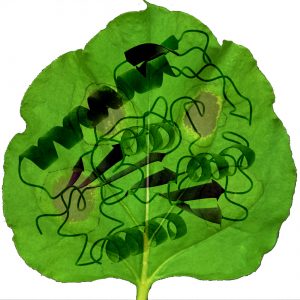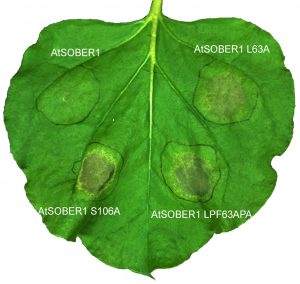La Jolla, California, USA
January 8, 2018
When you see brown spots on otherwise healthy green leaves, you may be witnessing a plant’s immune response as it tries to keep a bacterial infection from spreading. Some plants are more resistant to such infections than others, and plant biologists want to understand why. Salk Institute scientists studying a plant protein called SOBER1 recently discovered one mechanism by which, counterintuitively, plants seem to render themselves less resistant to infection.

This cartoon depicts a leaf with areas of damage (brown spots) caused by the plant’s innate immune response. The superimposed schematic shows SOBER1’s three-dimensional structure.
Click here for a high-resolution image.
Credit: Salk Institute
The work, which appeared in Nature Communications on December 19, 2017, sheds light on plant resistance generally and could lead to strategies to boost plants’ natural immunity or to better contain infections that threaten to destroy an entire agricultural crop.
“There are a lot of losses in crop yields due to bacteria that kill plants,” says the paper’s senior author Joanne Chory, a Howard Hughes Medical Institute Investigator, director of Salk’s Plant Molecular and Cellular Biology Laboratory and a 2018 recipient of the Breakthrough Prize in Life Sciences. “With this work, we set out to understand the underlying mechanism of how resistance works, and to see how general it is.”
One of the ways plants fight bacterial infection is by killing off their own cells in which bacterial proteins are detected. But some bacteria have evolved a counter strategy—injecting special proteins that suppress the plant’s immune response by adding small, disabling chemical tags called acetyl groups to immune molecules. This process is called acetylation. What makes certain plants able to resist these bacterial counter measures while others succumb to infection remains unclear.
As a means to better understand such pathogen-plant interactions, Chory’s team turned to the well-studied weed Arabidopsis thaliana and, in particular, an enzyme called SOBER1—which had previously been reported to suppress the weed’s immune response to a bacterial protein known as AvrBsT. While it may seem counterintuitive to use immune suppression to study infection resistance, the Salk biologists thought doing so could yield useful information.
The researchers started by determining SOBER1’s amino acid sequence—the particular order of building blocks that gives a protein its basic identity. Intriguingly, they found it was very similar to a cancer-pathway-related human enzyme. This enzyme contains a characteristic tunnel into which proteins with certain types of modifications can fit and be cut as part of the enzymatic reaction. It turns out SOBER1 can be classified as part of a vast protein superfamily known as alpha/beta hydrolases. These enzymes share a common core structure but are very flexible in the chemical reactions they catalyze, which range from the breakdown of fat to the detoxification of chemicals called peroxides.

This image shows four areas of a tobacco leaf in which AvrBsT protein has been produced, along with the normal version of the counter-reacting deacetylase (AtSOBER1, upper left) and several mutant versions. The right side shows SOBER1 mutants in which the newly discovered substrate tunnel has been manipulated. The normal version of SOBER1 has the healthiest-looking tissue, because the plant’s tissue-killing immune response has been blocked by SOBER1.
Click here for a high-resolution image
Credit: Salk Institute
Next, they used a more than 100-year-old technique called X-ray crystallography to determine SOBER1’s three-dimensional structure. While similar to the human enzyme, the plant enzyme’s tunnel had two extra amino acids sticking down from the top: one at the entrance and one in the middle.
“When we saw those, we realized they had to have a dramatic effect on function because they basically block the tunnel,” says Salk research associate and co–first author Marco Bürger.
To discover what the purpose might be, Bürger and co–first author Björn Willige, also a research associate, used substrates (molecules that enzymes act on) with different lengths and biochemically tested how well they fit in the enzyme and whether they could be cut. Only certain types fit and were cut—very short acetyl groups. This suggested that SOBER1 is a deacetylase—a class of enzyme that removes acetyl groups. Furthermore, the team mutated SOBER1 and thus opened the blocked tunnel. With this change, Bürger and Willige engineered an enzyme that lost its strong specificity for short acetyl groups and instead preferred longer substrates.
“For the initial biochemistry experiments, we used established, artificial substrates,” says Willige. “But next we wanted to see what would happen in plants.”
For this, they used tobacco plants—which have large leaves that are easy to work with—and a bacterium with a protein called AvrBsT, known to trigger acetylation. They produced AvrBsT in different regions of tobacco leaves along with SOBER1 and several mutated (and thus nonfunctional) versions of the enzyme.
Leaves producing AvrBsT had brown patches of dead tissue, indicating that AvrBsT had initiated a cell death program to curtail the systemic spreading of the pathogen. Leaves that produced AvrBsT together with SOBER1 looked healthy, indicating that SOBER1 reversed the action of AvrBsT. Strikingly, mutated SOBER1 versions with an opened tunnel were not able to prevent the tissue from dying. From this, the researchers concluded that deacetylation must be the underlying chemical reaction leading to suppression of the plant’s immune response.
The tobacco tests supported the idea of SOBER1 being a deacetylase that would remove acetyl groups added by bacterial proteins. Without the acetyl groups tagging proteins, the plant didn’t recognize them as foreign and thus didn’t mount a cell-killing immune response. The leaves looked healthier because cells weren’t dying.
“SOBER’s function is surprising because it keeps infected tissue alive, which puts the plant at risk,” says Chory, who also holds the Howard H. and Maryam R. Newman Chair in Plant Biology at Salk. “But we are just beginning to understand these types of mechanisms, and there could very well be conditions in which the actions of SOBER1 is beneficial.”
Further tests showed that the activity and function of SOBER1 is not restricted to the weed Arabidopsis thaliana, but also exists in a plant called oilseed rape demonstrating that the findings of Chory’s lab could be applied to agricultural crops and biofuel resources.
Bürger and Willige would next like to begin screening for chemical inhibitors that could block SOBER1, thereby allowing plants to have a full immune response to pathogenic bacteria.
The work was funded by Howard Hughes Medical Institute, Deutsche Forschungsgemeinschaft, the Human Frontier Science Program and The Pioneer Postdoctoral Endowment Fund.